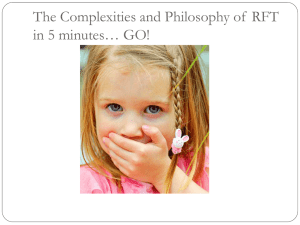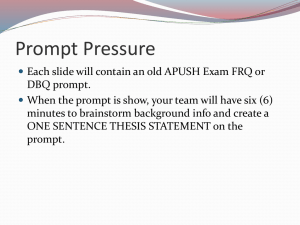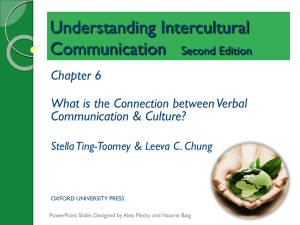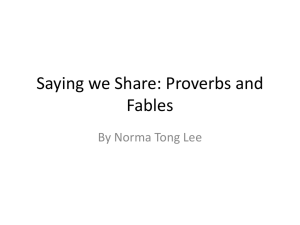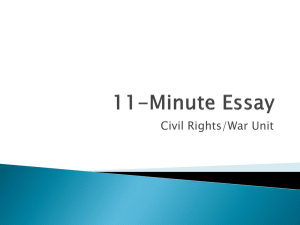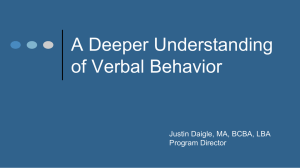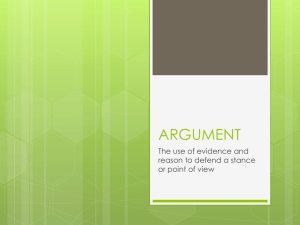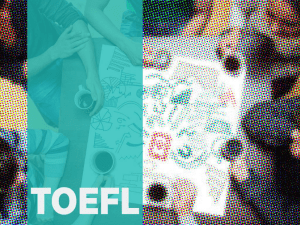The College of New Jersey - Career & Community Studies
advertisement
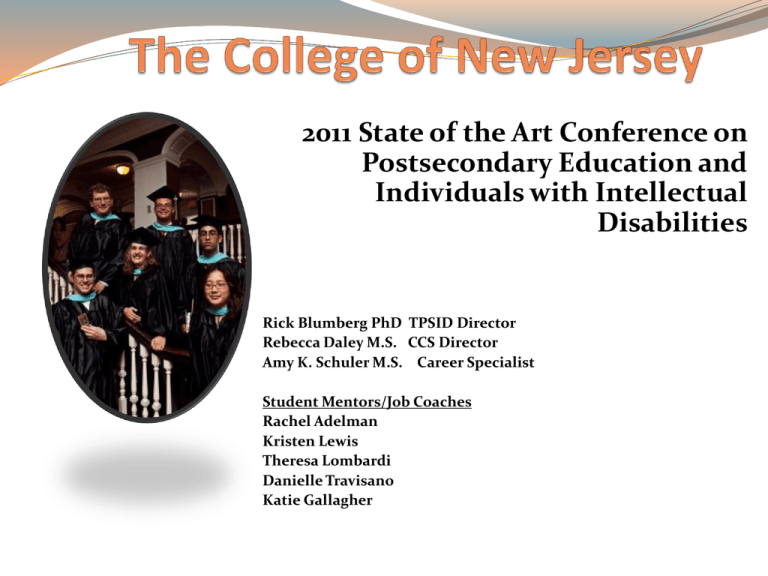
2011 State of the Art Conference on Postsecondary Education and Individuals with Intellectual Disabilities Rick Blumberg PhD TPSID Director Rebecca Daley M.S. CCS Director Amy K. Schuler M.S. Career Specialist Student Mentors/Job Coaches Rachel Adelman Kristen Lewis Theresa Lombardi Danielle Travisano Katie Gallagher Program Attributes Approved CTP program Full-time four year program Ages 18-25 at time of admission Cohort model Mentor supported Certificate from TCNJ Alumni activities and events CCS Components Liberal learning CCS Core Curriculum Inclusive TCNJ coursework Career exploration On campus practicum Community Internship Socialization/self determination Extracurricular activities Independent living CCS students First cohort Fall 2006 Twelve student graduates Currently enrolled 34 students Residential /off campus housing 29 Funding resources DDD Real Life Choices School District FAFSA eligible Pell Grant TCNJ Scholarship Student’s work experiences The Need We discovered early in the development of our program that: most incoming freshman had little knowledge of their disability had engaged in few career development activities in High School and so, had little information upon which to develop meaningful career goals. Career Development We adopted the career development stage framework articulated by Brolin (1997) in designing coursework and related experiences. These development stages includes Career awareness, Career Development Exploration Preparation, and Assimilation Awareness Exploration Preparation Assimilation Career Awareness Approached during Freshman year through self assessment and knowledge development activities. Through Career Exploration coursework, students are exposed to content that addresses: Why people work, The benefits of employment, Types of careers people engage in, & Work expectations including: Education, Training, and Skill requirements Self Assessment Students begin to identify their abilities, Interests, and preferences. An important outcome is the student’s developing understanding of the types of accommodations and supports he/she needs to be successful. Career Exploration In Sophomore year, students begin a series of brief on-campus work experiences in occupational “clusters” Administrative/Office mgmt Information Technology Health/Fitness Retail/Customer service Hospitality Career Exploration Sophomores choose experiences within these clusters based upon their individual interests and preferences Work experiences are task analyzed so that job coaching can be effectively provided by peer mentors, and students receive clear feedback on their performance These on-campus work experiences are generally the same offered other typically admitted undergraduates Career Preparation Conducted during Junior year with 1-2 on campus work experiences that reflect the student’s emerging career goals, and represent a good match between abilities, skills and preferences. Career coursework focuses on resume development, interview skills and an exploration of available community based internships/employment opportunities Career Assimilation Is accomplished during senior year through an intensive (12-15hr. per wk.) internship or paid employment experience. Workplace support is provided by trained peer mentors and supervised by CCS Faculty. Data is collected and reviewed with students to evaluate their performance, workplace accommodations, and the “match” between the student and job/career path Practicum and Internships On Campus Off Campus Admissions Sodexo food Service Records & Registration Mailroom Kids-Bridge Museum Library Public Relations Media Technology Information Technology NJ state Nursing Association Mercer ARC WaWa Educational Testing Services Stepping Stone Learning Institute Hopewell Physical Therapy Michaels NJ Credit Union American Cancer Society NJ State Dept Of Disability Service Video Modeling Video modeling (VM) typically involves a person viewing a clip of someone performing the steps of a task/skill, and then performing that task themselves. It involves visual and auditory prompting Recent research suggests that VM can be used to successfully teach a variety of skills (academic, career, social, self care) to individuals with IDD. (Rehfelt at al, 2003; Mangiapello & Taylor, 2003; & Nikopolous & Keenan, 2003) A Promising Practice VM appears to improve the pace of learning, improve task accuracy/quality, improve generalization, and increase independence (Van Laarhoven et al, 2009; Students may prefer VM to traditional forms of systematic instruction (Hume, Loftin & Lantz, 2009) It does not appear to matter if the student views him/herself or others modeling the task/skill A Pilot Demonstration To get some experience with VM and it’s application to College students with IDD, we conducted a pilot demonstration in Fall 2001 semester We wanted to see how iPAD technology could be used to help students learn job skills and the social skills associated with them. Our Process Task analyze on-campus work experiences Demonstrate the tasks for students Direct students to perform the tasks Provide a hierarchy of prompts until students complete the task (gestural, verbal, physical w/ verbal direction, modeling w/verbal direction Take observational data on the types of prompts needed Using video Create film clips of the task analysis using student models Provide visual and verbal directions within the video Have students view the video prior to performing the task Remind students that they can view the video as needed Take observational data on the number of times students view the video to independent task completion Ateev Sophomore Polite, wants to be liked by others Does not respond well to social cues, difficulty with social interactions He has difficulty initiating interactions/conversations with peers at lunch Baseline Data: Ateev # Trial Steps 1 2 3 1 Walk up to the person. 2 0 1 2 Look them in the eyes and say hello. 1 2 2 3 After they respond, ask them how their day is going. 2 2 2 4 Once they answer, them them know how your day is going. 0 0 0 5 Ask that person if they would like to sit with you for lunch. 2 0 2 6 If they say yes, guide them to your seat. 1 2 2 7 Continue conversation by saying, "What classes do you have this afternoon?" 2x 8 Do not repeat any questions you have asked or anything you have said. 0 0 0 9 Do not repeat anything your friend has said. 0 0 0 Total 10 6 13 Date 9/30 9/30 10/4 0 = Independent Response 1 = Gestural Prompt Only 2 = Verbal Prompt Only 4 = Modeling Prompt w/ Verbal Direction 3 = Physical Prompt w/ Verbal Direction 5 = Direct Physical Assistance w/ Verbal Direction 4 Video: Initiating Conversation Post-Data: Ateev # Trial Steps 4 5 6 1 Walk up to the person. 0 0 0 0 0 2 2 Look them in the eyes and say hello. 0 0 0 0 0 0 3 After they respond, ask them how their day is going. 0 0 0 0 0 0 4 Once they answer, them them know how your day is going. 0 0 0 0 0 0 5 Ask that person if they would like to sit with you for lunch. 0 0 0 0 0 0 6 If they say yes, guide them to your seat. 0 0 0 0 0 0 7 Continue converstaion by saying, "What classes do you have this afternoon?" 0 1 0 1 0 0 8 Do not repeat any questions you have asked or anything you have said. 0 0 0 0 0 0 9 Do not repeat anything your friend has said. 0 0 0 0 0 0 0 1 0 1 0 2 0 = Independent Response 2 = Verbal Prompt Only 4 = Modeling Prompt w/ Verbal Direction Total 1 = Gestural Prompt Only 3 = Physical Prompt w/ Verbal Direction 5 = Direct Physical Assistance w/ Verbal Direction Date 10/20 10/21 10/25 Graph Data Social Skills post-iPad 5 5 4 4 3 Trial 1 2 Trial 2 Trial 3 1 Level of Prompting Level of Prompting Social Skills pre-iPad Trial 4a 3 Trial 4b Trial 5a 2 Trial 5b Trial 6a 1 Trial 6b 0 0 1 2 3 4 5 6 Step Number 7 8 9 1 2 3 4 5 6 Stemp Number 7 8 9 Chelsea Junior Hardworking, sweet personality Waitress in 1855 dining hall Task: serving drinks to customers Incorporates social skills with multi-step tasks Baseline Data: Ordering water # Trial Steps 1 1 Go up to a customer that has not been waited on. 2 2 Ask them what they would like to drink. 2 3 Get a cup off the shelf. 0 4 Put a big scoop of ice into it. 2 5 Push the blue water fountain button. 0 6 Bring the drink back to the customer. 0 0 = Independent Response 2 = Verbal Prompt Only 4 = Modeling Prompt w/ Verbal Direction Total 1 = Gestural Prompt Only 3 = Physical Prompt w/ Verbal Direction 5 = Direct Physical Assistance w/ Verbal Direction Date 6 Video: Ordering Water Post-Data: water # Trial Steps 2 1 Go up to a customer that has not been waited on. 0 0 2 Ask them what they would like to drink. 0 0 3 Get a cup off the shelf. 0 0 4 Put a big scoop of ice into it. 0 0 5 Push the blue water fountain button. 0 0 6 Bring the drink back to the customer. 0 0 0 0 0 = Independent Response 2 = Verbal Prompt Only 4 = Modeling Prompt w/ Verbal Direction Total 1 = Gestural Prompt Only 3 = Physical Prompt w/ Verbal Direction 5 = Direct Physical Assistance w/ Verbal Direction Date Graph Data Serving Water post-iPad 5 5 4 4 3 Trial 1 2 1 Level of Prompting Level of Prompting Serving Water pre-iPad 3 Trial 2a 2 Trial 2b 1 0 0 1 2 3 4 Step Number 5 6 1 2 3 4 Step Number 5 6 Baseline Data: ordering coffee # Trial Steps 1 2 1 Go up to a customer that has not been waited on. 2 0 2 Ask them what they would like to drink. 0 0 3 Get a coffee cup off of the shelf. 2 0 4 Press the orange decaf button down. 2 2 5 Put the coffee on a plate. 0 2 6 Put a spoon on the plate. 0 0 7 Put crème on the plate. 0 0 8 Bring the coffee back to the customer. 0 0 6 4 0 = Independent Response 2 = Verbal Prompt Only 4 = Modeling Prompt w/ Verbal Direction Total 1 = Gestural Prompt Only 3 = Physical Prompt w/ Verbal Direction 5 = Direct Physical Assistance w/ Verbal Direction Date Video: Ordering Coffee Post-Data: Coffee # Trial Steps 3 4 5 1 Go up to a customer that has not been waited on. 0 0 0 0 0 0 2 Ask them what they would like to drink. 0 0 0 0 0 0 3 Get a coffee cup off of the shelf. 0 0 0 0 0 0 4 Press the orange decaf button down. 0 0 0 0 0 0 5 Put the coffee on a plate. 0 0 0 0 0 0 6 Put a spoon on the plate. 0 0 0 0 0 0 7 Put crème on the plate. 0 0 0 0 0 0 8 Bring the coffee back to the customer. 0 0 0 0 0 0 0 0 0 0 0 0 0 = Independent Response 2 = Verbal Prompt Only 4 = Modeling Prompt w/ Verbal Direction Total 1 = Gestural Prompt Only 3 = Physical Prompt w/ Verbal Direction 5 = Direct Physical Assistance w/ Verbal Direction Date Graph Data Serving Coffee post-iPad 5 5 4 4 3 Trial 1 2 Trial 2 1 Level of Prompting Level of Prompting Serving Coffee pre-iPad Trial 3a 3 Trial 3b Trial 4a 2 Trial 4b Trial 5a Trial 5b 1 0 0 1 2 3 4 5 Step Number 6 7 8 1 2 3 4 5 Step Number 6 7 8 Baseline Data: Ellis # Steps Trial 2 1 3 1 Lift up your collar. 1 1 1 2 Put the tie around your neck with the wide end on the right side and the narrow end on the left side 1 0 1 3 4 Hold wide end of tie with right hand and narrow end of tie with left hand. Adjust the length, so that the narrow end is at the tip of your pants. 0 2 0 2 0 2 5 Using the right hand, cross the wide end of the tie over the narrow end of the tie. 1 0 1 6 Switch your hands, so that the wide end is in your left hand and the narrow end is in your right hand. 2 0 0 7 Using your left hand, bring the wide end of the tie behind the narrow end ending on the right side. 2 1 2 8 Switch your hands again, so that the right hand is holding the wide end and the left hand is holding the narrow end. 0 0 0 9 Using your right hand, cross the wide end in front of the tie ending on the left side. 2 2 2 10 Switch your hands, so that the wide end of the tie is in your left hand and the narrow end is in your right hand. 0 0 0 11 Using your left hand, bring the wide end of the tie up through the loop that was created around your neck and pull it through. 3 3 3 12 Still using the left hand, take the wide end of the tie and put it through the loop at the frong of the tie. 3 3 3 13 Slowly move the tie up making it tight and straight. Put your collar down. 2 1 0 1 0 1 Total 20 13 16 Date 10/13 10/13 10/13 14 0 = Independent Response 1 = Gestural Prompt Only 2 = Verbal Prompt Only 4 = Modeling Prompt w/ Verbal Direction 3 = Physical Prompt w/ Verbal Direction 5 = Direct Physical Assistance w/ Verbal Direction Ellis Sophomore Quiet, polite. Likes to work on his own (without mentor support) Work experience: MTSS/tech Skill: tying a tie Wanted to learn, helpful for internships and job interviews Video: Tying a Tie Post-Data: Ellis # Steps 1 5 0 0 0 1 0 0 0 1 0 0 1 0 13 Adjust the length, so that the narrow end is at the tip of your pants. Using the right hand, cross the wide end of the tie over the narrow end of the tie. Switch your hands, so that the wide end is in your left hand and the narrow end is in your right hand. Using your left hand, bring the wide end of the tie behind the narrow end ending on the right side. Switch your hands again, so that the right hand is holding the wide end and the left hand is holding the narrow end. Using your right hand, cross the wide end in front of the tie ending on the left side. Switch your hands, so that the wide end of the tie is in your left hand and the narrow end is in your right hand. Using your left hand, bring the wide end of the tie up through the loop that was created around your neck and pull it through. Still using the left hand, take the wide end of the tie and put it through the loop at the frong of the tie. Slowly move the tie up making it tight and straight. 14 Put your collar down. 1 2 3 4 5 6 7 8 9 10 11 12 Lift up your collar. Put the tie around your neck with the wide end on the right side and the narrow end on the left side Hold wide end of tie with right hand and narrow end of tie with left hand. 0 = Independent Response 2 = Verbal Prompt Only 4 = Modeling Prompt w/ Verbal Direction 1 = Gestural Prompt Only 3 = Physical Prompt w/ Verbal Direction 5 = Direct Physical Assistance w/ Verbal Direction Total Date 4 0 Trial 6 0 7 8 0 0 0 0 0 0 0 0 0 0 0 0 0 0 0 0 0 0 0 0 0 0 0 0 0 0 1 0 0 0 0 0 0 0 0 0 1 0 0 0 0 0 0 0 0 0 1 0 0 0 0 0 0 0 0 0 1 0 0 0 0 0 0 0 0 0 1 0 0 0 0 0 0 0 0 0 1 0 1 0 0 0 0 0 0 0 2 0 1 0 0 0 1 0 0 0 1 0 1 0 0 0 2 0 1 0 1 0 0 0 0 0 0 0 0 0 1 0 0 0 0 0 0 0 0 0 15 0 3 0 0 0 3 0 1 10/25 10/25 10/25 10/28 10/28 Graph Data Tie with Ellie post-iPad 5 5 4 4 3 Trial 1 Trial 2 2 Trial 3 1 Level of Prompting Level of Prompting Tie with Ellis pre-iPad Trial 4a Trial 4b Trial 5a 3 Trial 5b Trial 6a 2 Trial 6b Trial 7a Trial 7b 1 Trial 8a Trial 8b 0 1 2 3 4 5 6 7 8 9 10 11 12 13 14 Step Number 0 1 2 3 4 5 6 7 8 9 10 11 12 13 14 Step Number Lauren Junior Very social and affectionate Works in Records and Registration Observed that she tended to hug and say “I love you” to 0thers including her supervisor Skill: appropriately greeting her supervisor at start of shift Baseline Data: Lauren Trial # 1 2 1 Look the person in the eyes and say, "Hi! How are you today?" 0 0 2 When they finish answering your question, tell them how your day is going 2 2 3 Then ask, "What tasks would you like me to do today?" 2 2 4 After the person finishes explaining your tasks, say, "Great! I will get right to work!" 2 2 5 Do no tell the person you love them. 2 0 6 Do not give the person a hug. 0 0 8 6 0 = Independent Response 2 = Verbal Prompt Only 4 = Modeling Prompt w/ Verbal Direction Total 1 = Gestural Prompt Only 3 = Physical Prompt w/ Verbal Direction 5 = Direct Physical Assistance w/ Verbal Direction Date Video: Conversation at Work Post-Data: Lauren Trial # 3 4 5 1 Look the person in the eyes and say, "Hi! How are you today?" 0 0 0 0 0 0 2 When they finish answering your question, tell them how your day is going 0 0 0 0 0 0 3 Then ask, "What tasks would you like me to do today?" 0 1 0 0 0 0 4 After the person finishes explaining your tasks, say, "Great! I will get right to work!" 0 0 0 0 0 0 5 Do no tell the person you love them. 0 0 0 0 0 0 6 Do not give the person a hug. 0 0 0 0 0 0 0 1 0 0 0 0 0 = Independent Response 2 = Verbal Prompt Only 4 = Modeling Prompt w/ Verbal Direction Total 1 = Gestural Prompt Only 3 = Physical Prompt w/ Verbal Direction 5 = Direct Physical Assistance w/ Verbal Direction Date 10/24 10/26 10/31 Graph Data Work Place Conversation post-iPad 5 5 4 4 3 Trial 1 2 Trial 2 Level of Prompting Level of Promting Work Place Converstaion preiPad Trial 3b Trial 4a 2 1 0 0 2 3 4 Step Number 5 6 Trial 4b Trial 5a 1 1 Trial 3a 3 Trial 5b 1 2 3 4 Step Number 5 6 Career And Community Studies (CCS)

